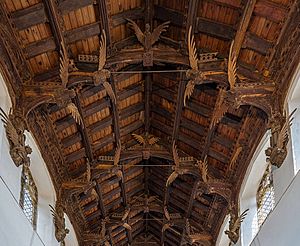Wendreda facts for kids
Quick facts for kids Saint Wendreda |
|
|---|---|
| Born | date unknown Perhaps Exning, Suffolk |
| Died | date unknown March, Isle of Ely |
| Venerated in | Roman Catholic Church Anglican Communion, Orthodox Church |
| Major shrine | Ely Cathedral; St Wendreda's Church, March |
| Feast | 22 January |
| Attributes | Nun, healer |
| Patronage | March, Cambridgeshire |
Saint Wendreda, also called Wendreth, was an Anglo-Saxon nun and healer. She lived a long time ago, possibly in the 600s. Some people believe she was the daughter of King Anna of East Anglia. If this is true, she would have been the sister of other well-known saints like Etheldreda and Sexburgha.
Wendreda is especially connected to the towns of March in the Isle of Ely and Exning in Suffolk.
Contents
Who Was Saint Wendreda?
Wendreda might have been a princess, growing up in Exning near Newmarket. Unlike some of her sisters who married kings, Wendreda chose a different path. She became a nun and was very skilled with plants and natural remedies. She was known as a herbalist, someone who uses plants to help sick people and animals.
She settled in the wet, marshy area called the Fens. Some stories say she started a Benedictine nunnery (a place where nuns live) in March. She spent the rest of her life there, becoming famous for her healing abilities. People even believed she had miraculous powers.
In the late 1800s, a writer named Frances Arnold-Forster mentioned that Wendreda might have been an abbess, which is the head of a nunnery. She noted that a small piece of land near the church in March was still called 'the Nunnery'. An old coffin lid was found there, suggesting it was once a burial site connected to a religious community.
Saint Wendreda's Relics and Church

The remains of Saint Wendreda, known as her relics, were once very important. A historian named Joseph Strutt wrote that her body was brought to Ely Cathedral. It was kept in a beautiful golden shrine decorated with jewels.
In 1016, a king named Edmund Ironside bought her relics. He hoped they would bring him victory in a battle against the Danes. However, Canute captured the relics after the Battle of Assandun. He later gave them to Canterbury Cathedral.
Many years later, in 1343, Wendreda's relics were returned to March. Today, no one knows exactly where they are. However, some old books from the 1800s and early 1900s claimed they were in a place called Eltisley.
The only church named after Saint Wendreda is in March. This church is famous for its incredible double-hammer beam roof. It has 118 angels carved from oak wood, celebrating the saint. The largest angels are almost life-size and look down into the church with their wings spread out. A famous writer, John Betjeman, said it was "worth cycling forty miles in a head wind to see!"
St Wendreda's Well
There is a natural spring in Exning that was once called St Mindred's Well. A local story says that Saint Wendreda used the water from this spring for her healing. Horse jockeys from Newmarket used to bring their horses there to drink before races.
Because there is no other record of a saint named Mindred, a scholar named Montague Rhodes James thought that Mindred and Wendreda were the same person. He wrote this in 1930. Today, this water source is called St Wendreda's Well. It is located on private land at the Hamilton Stud.
Growing Importance of Saint Wendreda
Over the centuries, Saint Wendreda's importance has grown far beyond her local area. In recent times, her story has even become part of wider discussions between different Christian churches. This shows how a local saint can become known and respected around the world.

